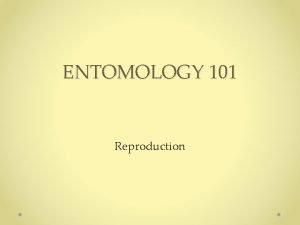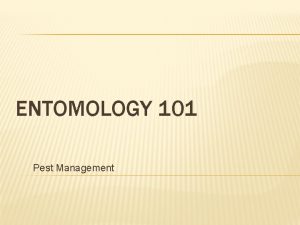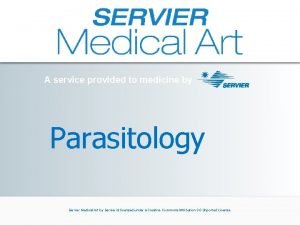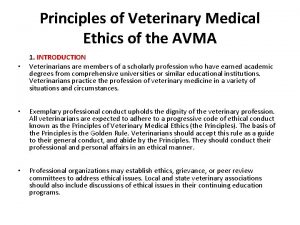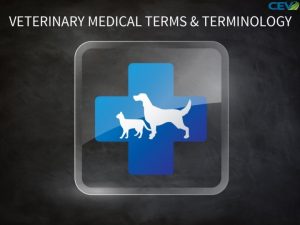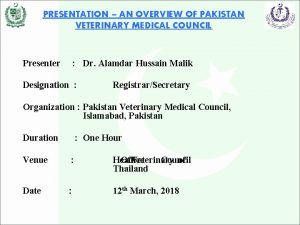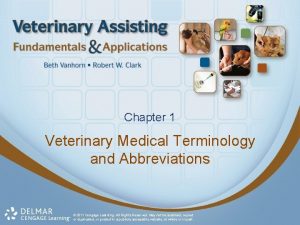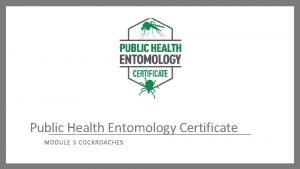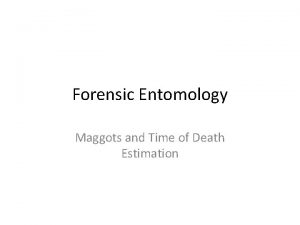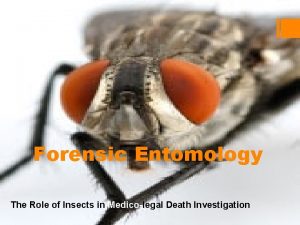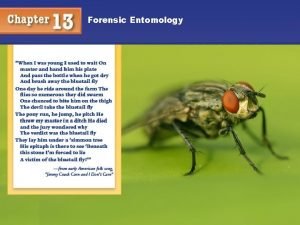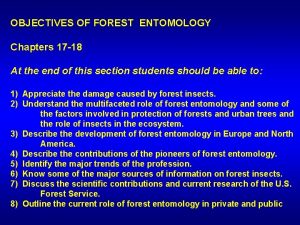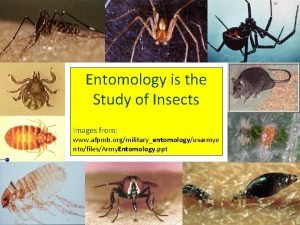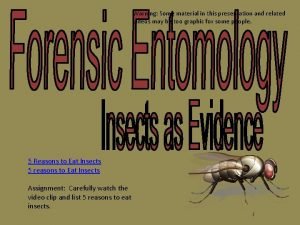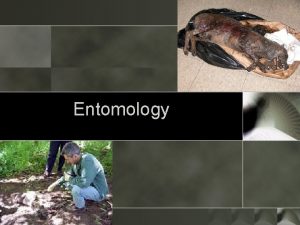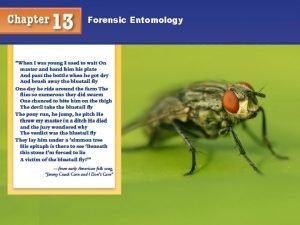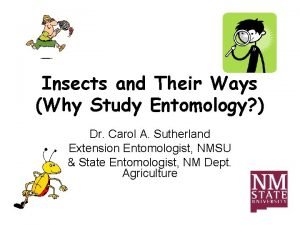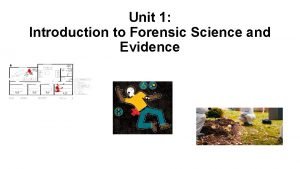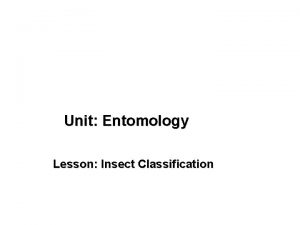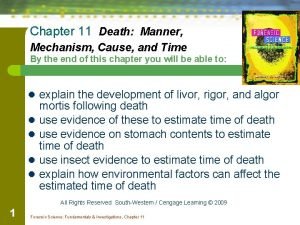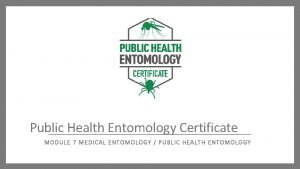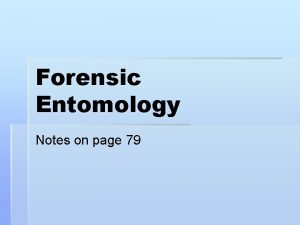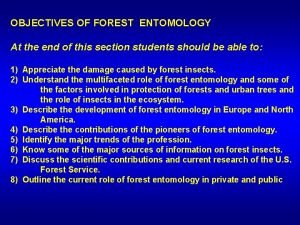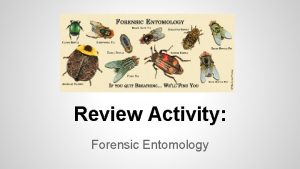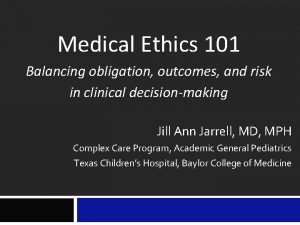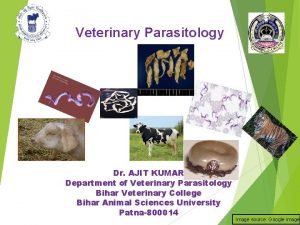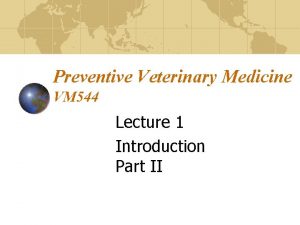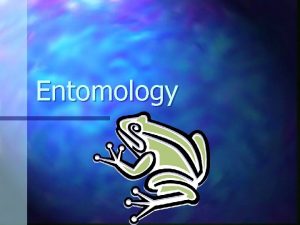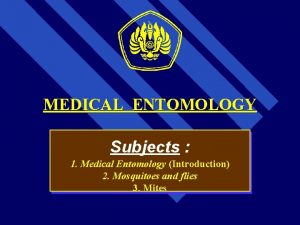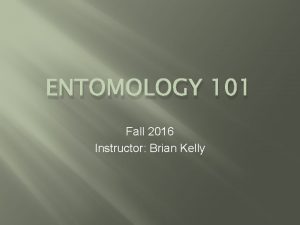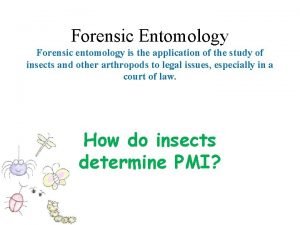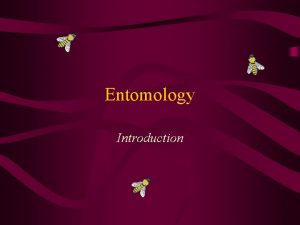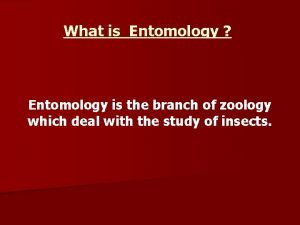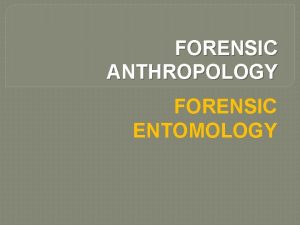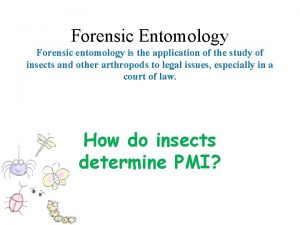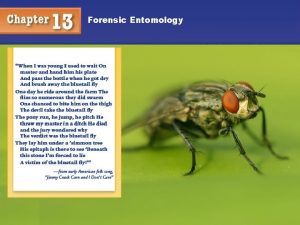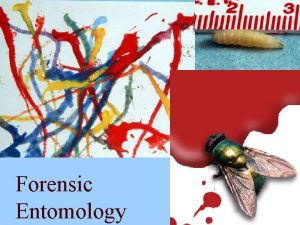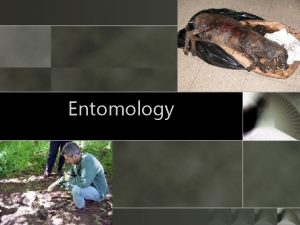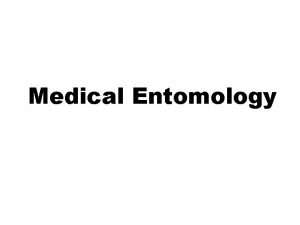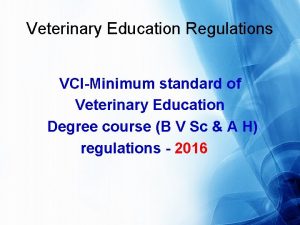ENTOMOLOGY 101 Medical Veterinary Entomology Medical Veterinary Entomology
































- Slides: 32

ENTOMOLOGY 101 Medical & Veterinary Entomology

Medical & Veterinary Entomology • Topics • • • Insect Nuisance and Phobia Venoms and Allergens Causes and Vectors of Disease Generalized Disease Cycles Pathogens Forensic Entomology

Medical & Veterinary Entomology • Major scientific disciplines due to: • • • Widespread impact Seriousness of consequences Frequency of nuisance Vector: organism that transmits a pathogen to another species Very broad in scope: • • • Motivation and study usually focused on the disease Must have wide understanding of host, vector, and parasite Have to consider other arthropods as well

Insect Nuisance and Phobia • Arachnophobia – fear of spiders and other arachnids • • • Many different physical reactions Even a picture / drawing can trigger it Little Miss Muffet Can the fear of spiders develop before birth? (crickets) Affects ~5% of the population Entomophobia – fear of insects

Insect Nuisance and Phobia • Delusory parasitosis • • • Aka “Ekbom’s syndrome”, a form of psychosis Strong delusional belief that they are infested with parasites Sensation of formication often manifests “Meth mites” and “cocaine bugs” Appropriate investigations often ought to be psychological

Insect Nuisance and Phobia • Bed bugs • Used to be a big problem • Nearly eradicated from the developing world in 1940 • • • Resurgence in numbers lately, since 1995 Can get them nearly anywhere Signs / symptoms: • Mysterious bites, specks of blood on sheets, sweet / sickly odor • Hiding spots in the daytime • Where to look and how to check • “Harborages” • Earliest recorded use of the word “bug” referred to bed bugs!

Insect Nuisance and Phobia • Swarms of insects • • • Buzzers Biters Mayflies on roads

Venoms and Allergens • • Insect venoms Blister- and itch-inducing insects • Blister beetles • Cantharadins • “Spanish fly” • Caterpillars • Urtication • Hollow spines – venom released when broken • Deaths • Tarantulas

Venoms and Allergens • Insect allergenicity • • • Insect allergens Common in those who handle insects for their job Stored products (infested with mites) Fecal material of house-dust mites Cockroaches and frass Sensitization and anaphylactic shock • Bee stings • Epipens

Causes and Vectors of Disease • Insects can transmit: protists, viruses, bacteria, nematodes • Such diseases include: malaria, dengue, yellow fever, onchocerciasis, leishmaniasis, filariasis, and trypanosomiasis • Diseases may be caused by: • The insect itself • Lice – pediculosis • Mite – scabies • Flies – myiasis, strike, screw-worms • Pathogen from an insect vector • Mechanical transfer • Biological transfer • Disease control requires detailed knowledge of the biology of all 3 components: vector, pathogen, host

Generalized Disease Cycles • • • Host: organism that harbors the pathogen Reservoir: natural host and geographical range; can harbor the pathogen indefinitely with no ill effects Single cycle • • Pathogen completes its lifecycle in vector and human host only It is rare Ex: malaria Ex: filariasis

Generalized Disease Cycles • Secondary cycle • • Outbreaks and spread • • A different animal serves as a primary host Human inclusion not required for completion of disease cycle More common Ex: monkeys & yellow fever Ex: rats & bubonic plague Ex: desert rodents & leishmaniasis “Sylvan” cycle - monkeys and humans Disease control is complicated • • Presence of reservoirs Encroachment of people

Pathogens • • Arbovirus: an ARthropod-BOrne virus Malaria • • Affects more people than any other insect-borne disease 214 million cases in 2015 Estimated ½ million + deaths every year Exposure rate lowered in the past, but has risen steadily lately “Roman fever” / “marsh fever” Used to be common in the U. S. and N. A. Always vectored by Anopheles mosquitos

Pathogens • Malaria • • Sporozoan: Plasmodium Life cycle • Incubation period and time frames • 5 different parasites and their effects

Pathogens • Malaria • Epidemiology • Endemic: geographical area a disease is typically restricted to • Epidemic: the spread or breakout of a disease • Disease transmission is understood in the potential of the vector: • • Vector distribution Vector abundance Life expectancy of the vector Anthropophily Feeding rate of the vector Vector competence Vectorial capacity

Pathogens • Malaria • Epidemiology • Vector distribution • Anopheles mosquitos occur almost worldwide • Mostly found in warm climates • A select few species vector the majority of the pathogens

Pathogens • Malaria • Epidemiology • Vector abundance • • • Development is temperature-dependent Generation time can be as short as 10 days in the tropics Potential for 100 -fold increase in adults in 14 days Increased rainfall typically increases numbers Adult survivorship related to elevated humidity

Pathogens • Malaria • Epidemiology • Life expectancy of the vector • Lifespan is of great significance • No disease is transmitted if the vector dies too soon • Anthropophily of the vector • • • Must feed twice to be a vector Propensity of vector to feed on host Preference for humans (anthropophily) over others (zoophily) Stable malaria and anthropophilic vectors Transmission can take place even under low populations

Pathogens • Malaria • Epidemiology • Feeding rate of the vector • • Frequency of feeding is important in disease transmission Number of blood meals needed for eggs Already-infected vectors may have difficulty feeding Disturbance may lead to multiple transmissions • Vectorial capacity • Mathematical expression of the probability of disease transmission by the vector • Factors involved

Pathogens • Malaria • Control • 2 pronged approach: mosquitos or disease • Mosquitos – spraying on a large and small scale • Mosquitos – bed nets • Disease – an infected person will not transmit the disease if treated within the first 10 days • Disease – where treated, incidence rate fell by over 99% • Disease – prompt detection and treatment are key

Pathogens • Arboviruses • Modes of transmission • Vertical • Horizontal • • Yellow fever Encephalitis, Japanese encephalitis Bluetongue virus Dengue • Symptoms • Vector • Spread

Pathogens • Arboviruses • West Nile virus • • Part of the Japanese encephalitis complex Originally from the West Nile district of Uganda Symptoms Principle vectors are bird-feeding Culex mosquitos birds are natural reservoirs and principle hosts First appeared in 1999 in New York Extraordinary spread across almost all of North America

Pathogens • Rickettsias and plague • • Bacteria Typhus • Caused millions of deaths over hundreds of years • Vector is lice (body louse) • • Other types of typhus and their vectors Plague, aka “Black Death” • Found in rodents, vectored by fleas • In only 5 years (1347 -1352), 25 million people died

Pathogens • Protists • • Malaria Trypanosoma • • • Transmitted by blood-feeding flies and “kissing bugs” Chagas’ disease Affects millions and causes tens of thousands of deaths annually Presence in Colorado Sleeping sickness • Humans and cattle in Africa • Tsetse fly • Leishmaniasis • Sand flies • Disfigurement

Pathogens • Filariases • Canine heartworm • Elephantiasis aka lymphatic filariasis • • • Vectored by Culex mosquitos Cycle and transmission Severe swelling, mainly in legs and genitals Worms live only in the lymphatic system No vaccine, but treatment exists Onchocerciasis aka river blindness • • • Debilitating, but does not cause death Vectored by Simulium black flies Worms invade eye tissues and die there 37 million people are infected 99% of cases occur in Africa “OCP” – launched in 1974

Forensic Entomology • Divided into 3 sub-fields 1. Urban forensic entomology � Pest infestations in buildings � Between private parties and landlords or exterminators 2. Stored-product forensic entomology � Infestation of commercially distributed foods 3. Medico-legal forensic entomology � Used in cases of: murder, rape, suicide, physical abuse, contraband � Some prominent murder cases • Sung Tzu

Forensic Entomology • 5 stages of decay: 1. Initial decay • aka “fresh” 2. Putrefaction • aka “bloat” 3. Black putrefaction • aka “active decay” 4. Butyric fermentation • aka “advanced decay” 5. Dry decay • Typical succession

Forensic Entomology • Insects of most importance in forensics • • Flies Beetles • Post mortem interval (PMI) • Accumulated degree days • Estimating time of death • Importance of environmental factors • • Moisture level Exposure: sun / air / water Geography Various weather conditions

Forensic Entomology • Career as a forensic entomologist • • ABFE – American Board of Forensic Entomology Only 17 in all of North America

Pictures by Slide no modifications were made to any pictures on any of the slides 1. 2. 3. 4. 5. 6. 7. 8. 9. 10. 11. 12. 13. 14. 15. 16. 17. 18. 19. 20. 21. 22. 23. 24. 25. 26. 27. 28. 29. (no picture) The Far Side Gallery 1 by Gary Larson, 1984, page 168 https: //commons. wikimedia. org/wiki/File: Little_Miss_Muffet_2_-_WW_Denslow_-_Project_Gutenberg_etext_18546. jpg https: //commons. wikimedia. org/wiki/File: Derma_me. JPG https: //commons. wikimedia. org/wiki/File: Bedbugs. jpg The Far Side Gallery 4 by Gary Larson, 1993, page 14 http: //bugguide. net/node/view/455085/bgimage - James Reben https: //commons. wikimedia. org/wiki/File: Bienenstich_18 a. jpg https: //commons. wikimedia. org/wiki/File: Gasterophilus-larvae. jpg https: //commons. wikimedia. org/wiki/File: Wuchereria_Life_Cycle. jpg http: //phil. cdc. gov/PHIL_Images/14997_lores. jpg (or search ‘yellow fever’ in PHIL) https: //commons. wikimedia. org/wiki/File: Anopheles_albimanus_mosquito. jpg Wiley Blackwell: The Insects: An Outline of Entomology, 4 th edition – Box 15. 1 The Far Side Gallery 1 by Gary Larson, 1984, page 90 https: //commons. wikimedia. org/wiki/File: Anopheles-range-map. png https: //commons. wikimedia. org/wiki/File: Anopheles_Culex_larvae_feeding_position_CDC_mod. jpg The Far Side Gallery 3 by Gary Larson, 1988, page 154 https: //commons. wikimedia. org/wiki/File: Plasmodium_falciparum_02. jpg https: //commons. wikimedia. org/wiki/File: %22 Don%27 t_go_to_Bed_with_Malaria_Mosquito%22_-_NARA_-_514146. tif https: //commons. wikimedia. org/wiki/File: Aedes_aegypti_bloodfeeding_CDC_Gathany. jpg Wiley Blackwell: The Insects: An Outline of Entomology, 4 th edition – Box 15. 5 https: //commons. wikimedia. org/wiki/File: Black-tailed_Prairie_Dog_%28 standing%29. jpg https: //commons. wikimedia. org/wiki/File: Three_species_of_kissing_bugs. PNG https: //commons. wikimedia. org/wiki/File: River_blindness. jpg https: //commons. wikimedia. org/wiki/File: Hasiya_krish. jpg Wiley Blackwell: The Insects: An Outline of Entomology, 4 th edition – Figure 15. 2 https: //commons. wikimedia. org/wiki/File: Creophilus_maxillosus_%28 Linn%C 3%A 9, _1758%29_%283411620571%29. jpg https: //commons. wikimedia. org/wiki/File: T. J. _Thyne_at_Paleyfest_2012. jpg

Questions?

Permission
 Ovivoparity
Ovivoparity Entomology 101
Entomology 101 Schisotoma
Schisotoma Avma code of ethics
Avma code of ethics Common veterinary medical equipment vocabulary
Common veterinary medical equipment vocabulary Pakistan veterinary medical council
Pakistan veterinary medical council Gib medical abbreviation
Gib medical abbreviation Public health entomology certificate
Public health entomology certificate How to calculate adh forensics
How to calculate adh forensics Branches of zoology
Branches of zoology Medicolegal forensic entomology
Medicolegal forensic entomology Adh forensics
Adh forensics Forensic entomology equipment
Forensic entomology equipment Father of forest entomology
Father of forest entomology Vociferous chatter meaning
Vociferous chatter meaning Crime solving insects answer key
Crime solving insects answer key Crime solving insects answer key
Crime solving insects answer key Entomology is the study of
Entomology is the study of Forensic entomology lab activity
Forensic entomology lab activity Forensic entomology
Forensic entomology Why study entomology
Why study entomology Bobby poole and ronald cotton
Bobby poole and ronald cotton Site:slidetodoc.com
Site:slidetodoc.com Chapter 11 forensic entomology
Chapter 11 forensic entomology Zoonotic diseases
Zoonotic diseases Maggots
Maggots Father of forest entomology
Father of forest entomology Pro corbis
Pro corbis Adh forensics formula
Adh forensics formula Medical ethics 101
Medical ethics 101 Father of veterinary parasitology
Father of veterinary parasitology Veterinary root words
Veterinary root words Vm 544
Vm 544
